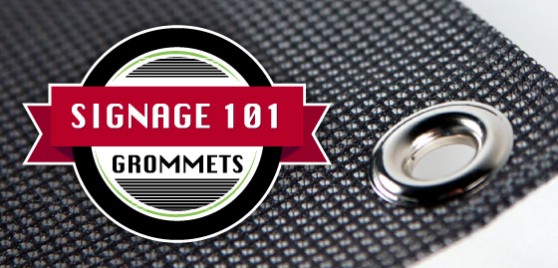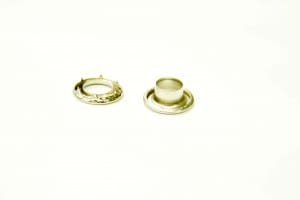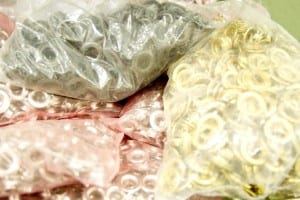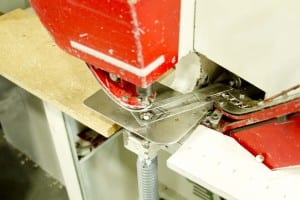
Working in signage everyday we fully understand just how many sign types and materials, options and usages of signs there are. As such, we’re going to start sharing some of this sign knowledge in a series called “Signage 101”. We’ll tackle signage related topics and help you understand it completely so you’re better prepared to customize and purchase the sign you need.
Grommets, Grommets and More Grommets
Grommets aren’t quite the smallest part of a sign, standoffs at the very least have them beat, but they are pretty close. We have quite a few people ask: “what are grommets?” so here’s a quick overview of what grommets are, why they are important and what else you should know about them.
What Is a Grommet?
Grommets, not gromits nor grommits, are small metal rings (also not “eyelets” as described below) that are typically used in signage including vinyl, fabric, and canvas banners, rigid plastic signs and corrugated plastic yard signs. You’ll also often see them in drapes and curtains in various shapes and forms. The purpose of a grommet is to provide a reinforced hole through which something passes through. The reinforced hole ensures that one can hang a sign (or curtain) without tearing the material itself.
Eyelets or Grommets?

Some within and without the sign industry refer to grommets as “eyelets”. While many use the terms interchangeably, doing so isn’t 100 percent accurate. Technically speaking there is one major difference. Eyelets are one piece of material such as brass or metal that is t-shaped and punched through the material. It is then compressed to make sure it stays in place. Grommets on the other hand are made up of two pieces as can be seen in the picture to the right. For example, two metal rings are placed on either side of the material (think canvas, vinyl, corrugated plastic, etc.) and then compressed to form a more durable grommet. Eyelets are often used in cases where a smaller answer is needed such as scrapbooking, crafting, clothing and even in shoes for shoelaces. Grommets are much stronger and used in situations that call for a more reinforced and longer lasting hold, such as permanent signage and heavy curtains or drapes.
What Types of Grommets Are There?
Grommets can come in a variety of materials. These materials include rubber, plastic, and  various types of metal. Our banners come standard with metal grommets. Each type of material has advantages and disadvantages but metal is typically the most popular type of grommet in banners and yard signs as well as drapes or curtains as they are the most durable. A few more of the pros and cons of the different types of grommets in general are outlined below.
various types of metal. Our banners come standard with metal grommets. Each type of material has advantages and disadvantages but metal is typically the most popular type of grommet in banners and yard signs as well as drapes or curtains as they are the most durable. A few more of the pros and cons of the different types of grommets in general are outlined below.
Rubber: The major advantage of using rubber grommets is to avoid the sharp edges produced by metal ones. These sharp edges can cause fraying or cutting of whatever is passing through the hole. Whether this is a rope or cord or in some cases electrical wire of some form, one can quickly see why it’s advantageous to avoid the sharp edges sometimes present in metal grommets. Rubber grommets can also help cabling or wire from being contaminated by water, air and dirt.
Plastic: Like rubber grommets a major advantage and use of plastic grommets is to prevent sharp edges from cutting or fraying whatever is passing through the hole. These grommets can either be truly plastic or simply plastic coated as both will achieve the end goal of not damaging the material. Plastic grommets, like rubber ones, also help prevent contamination from certain substances depending on what’s passing through the grommet.
Metal: Metal grommets as alluded to above have proven to be extremely durable. The most common type of metal grommet is a simple brass grommet. The durability of metal grommets coupled with the fact that in most cases the cord or rope passing through the hole will not chaff as much as other usages and therefore has lower risk of cutting whatever is used to hang the sign means that metal is the standard when it comes to signage grommets.
Standard Grommet Sizes
Just like most everything else there are certain standard sizes when it comes to grommets. Standard grommet sizes are usually as follows: 3/16”, ⅜”, ½”, 1 7/16” and 3”. Just remember that the “size” of the grommet is dictated by the interior diameter of the hole. In almost all cases the common ⅜” of an inch grommet that comes standard with our banners is perfect for your signage. It is worth noting that a ⅜” grommet measures 13/16” in circumference. Though as noted below this is still small enough that it won’t negatively affect the visual impact of your sign.
How Are Grommets Added to My Sign?
There are typically two ways that grommets are added to signs. These are the do it yourself approach and an industrial tool used by sign shops.
The first, and much less common, way is the DIY approach using a grommet gun, kit or tool. These tools are just like they sound and provide you with the grommets and some kind of hand tool in which you squeeze to compress and bind the grommets together. In doing so, it punches a hole and binds the grommet pieces together for the subsequent hanging of the sign. There are also tool kits that involve a hammer and punch in which you strike what is known as the “punch” to both create your hole and compress your grommets together. To easily visualize these, the hand compressors look like a bigger version of a paper hole punch while the hammer and punch are like a hammer and over-sized nail. These kits, tools and individual grommets can be purchased at any local or chain hardware store and even online through Amazon. In almost all cases doing it this way is not advised as grommets are free with most sign makers. Here at Signs.com we place grommets every 24 inches to ensure that there are plenty of places for you to hang your sign without it wrinkling. There shouldn’t be any need to hand install grommets!
 The more common way that grommets are added to your sign is an industrial grommet machine, like the one pictured to the right. These machines are operated by a worker who uses a hand or foot lever to make the machine compress the grommets and punch the hole. This method provides a cleaner hole and more professional installation of grommets than doing it yourself. Using such a machine means that for thinner materials the grommets can be punched while thicker materials may need to simply be drilled and then grommets glued into place. Either way the grommets will be installed in a professional way. The video below shows grommets being installed on a banner using a machine.
The more common way that grommets are added to your sign is an industrial grommet machine, like the one pictured to the right. These machines are operated by a worker who uses a hand or foot lever to make the machine compress the grommets and punch the hole. This method provides a cleaner hole and more professional installation of grommets than doing it yourself. Using such a machine means that for thinner materials the grommets can be punched while thicker materials may need to simply be drilled and then grommets glued into place. Either way the grommets will be installed in a professional way. The video below shows grommets being installed on a banner using a machine.
Grommets and Our Signage
Grommets come standard with a number of our custom banners at no extra charge while other types of signage that can include grommets need to be requested and cost a little extra since it is atypical. These will be ⅜” grommets placed every 24 inches around the perimeter of your sign. Though it’s your sign and if you want a different arrangement you just need to specify this during checkout. With all signage that has the option of adding grommets you can also opt to have no grommets. This is usually the case when the end usage of the sign won’t be to hang it but rather have it attached or affixed to something such as plywood.
As mentioned previously we can also adjust the grommets based on the size of the sign. For example, on over-sized signs such as large custom vinyl banners we can easily place grommets every 18 inches rather than 24 inches to ensure it can be hung for the long term without any problems. Though typically we’ve never had any problems with large signs that have grommets at the standard 24” intervals.
The grommets on your sign(s) will be placed approximately one inch from the edge. Keep this in mind as you’re designing your custom signage so that grommets don’t interfere with the actual design. Another design related consideration is the color of the grommet. Typically grommets are silver or brass like in color for metal grommets and black or gray for rubber and plastic grommets. Our standard metal grommets are generally silver in color. Though as small as they are this isn’t usually a big concern when it comes to aesthetics of the sign.
Other advantages of having grommets in your banners or signs is that they won’t rust and are perfect for the outdoors. Further, typically these grommets shouldn’t tear the material they are punched into assuming that extra weight or extenuating circumstances don’t come into play. This is especially the case with our banners which are scrim reinforced around the edge of the banner with a welded hem. This just means that the edges, where fraying typically occurs, is reinforced in way to ensure no tearing. Your grommets will be placed just inside the welded hem. So whether you end up using a zip tie, rope, bungee cord, or washers and bolts it is highly unlikely that your grommets will negatively affect or tear your actual sign.
Hopefully this quick post has answered your signage-related questions about grommets. If we’ve missed one of your questions feel free to contact us or leave a comment so we can add it to this page.



































